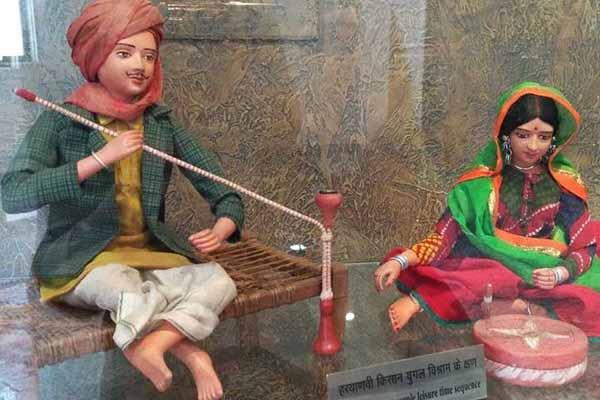Dolls Museum Jaipur is one of the oldest Museum in Rajathan situated in the centre of the sprawling Ram Niwas Bagh. It was built in 1876 when King Edward VII visited India as the Prince of Wales and designed by Colonel Sir Swinton Jacob.
The Museum has various sections like Art and Industry, Armoury, Textiles, Carpets, Paintings, Geology, Zoology, Botany, Toys & Dolls. There is a Persian garden carpet of a fabulous cost obtained by Mirza Raja Jai Singh I from Shah Abbas of Persia. It contains various sketches of a Persian garden with running water streams Jaipur Tourism.
There is also an Egyptian mummy belonging to the Ptolemaic Epoch. There are miniature paintings of various sub-schools of Rajasthan. A glimpse of the land and the people of Rajasthan are presented through well-planned dioramas Dolls Museum Jaipur.
Typical designs and motifs in Mehndi Mandana, characteristic of Rajasthani ladies, are also highlighted in the gallery. In the antechamber of the wing is exhibited puppetry from Rajasthan and the painted scroll delineating the scenes from Pabuji Rathore’s life, a great folk- hero from Marwar.
The central gallery is devoted to Rajasthani music and dance. Original musical instruments, both classical and folk, are displayed in their functional positions. Specimens include typical folk instruments like Masak, Kamayacha, Dadh, Madal, Khanjari, Sitari, Bankia, Fungi, Algoja, Iktara etc.
In the first courtyard, as you enter, stands a charming little square structure called the Mubarak Mahal, the guesthouse built by the royal family in the late 19th century. The carved stone and marble archways are in a style reminiscent of Mughal architecture, with a combination of Hindu and Islamic designs. This is a two-storeyed building: the ground floor is for administrative offices, and the first floor, approached by a narrow staircase to one side, contain the Textile Gallery.
In two of the rooms in the textile gallery there are displays of cotton hand-printed fabrics from Sanganer. The town of sanganer is 16 kilometres (10 miles) south of Jaipur, and is still the centre for delicate wood block-printed cloth. Among the embroidered item are samples worked with gold, with silver thread, with sequins and ribbons. Zari is gold, and zari work refers to the gold-thread embroidery that was popular with the ruling classes in north India. The workmanship on the huge flowing skirts and head covering (dupatta, or odhani) is superb.
There is a sad, rather dusty diorama of a palace room full of women dressed in Rajasthani attire – long skirts full of gathers, embroidered odhani, blouses and jewellery – which gives us some idea of how a variety of prints, brocades and embroidered items were worn together, to produce a rich and dazzling ensemble. The dances illustrated in the gallery include classical ones like Kathak, for which Jaipur Gharana is famous, as well as popular folk dances such as Dandia, Choomar, Holi etc. Festivals (like Holi, Gangaur etc.) and ceremonies (like marriage) are also dioramised in a lively manner. The museum functions as the State Museum of Rajasthan.
History of Dolls Museum Jaipur
The Dolls Museum was built up in 1974 by Shrimati Bhagwan Bai Gauridutt Sekhsaria Charitable Trust. Throughout the years, the gallery fell into disregard and the state of the dolls disintegrated. It was in the year 2014 that S.S. Bhandari, a fine auditor from Jaipur, alongside a gathering of devoted nationals revamped the historical center and exceeded the rebuilding of dolls with the assistance of workmanship conservator Rashmi Sharma.
Shivani Sethia, London, and Rotary Club, Japan have given English puppets and Japanese dolls to the gallery separately Jaipur Tour Packages. The doll buildup of the historical center showed in five exhibitions is from around 40 unique nations. The new wing of the exhibition hall, Savita Ranjit Singh Bhandari, is named after Bhandari’s folks. The exhibition hall houses Indian state dolls showed in exceptional attire reflecting wedding wear, ordinary apparel, and move outfits. The customary doll gathering from Japan, a large portion of which is produced using wood, incorporates Kokeshi dolls, Namahage dolls, Kamakura dolls, Kanto Matsuri dolls, and Tanabata Dolls Museum Jaipur.
Dolls Museum Jaipur made using paper and whale teeth from Japan are additionally in plain view. Dolls embellishing customary clothing from different nations, for example, Mexico, Italy, Turkey, Norway, Peru, Uganda, Burgundy, Mongolia and more draw in guest’s thought. The gallery likewise has an area of English puppets and high quality wooden toys.
Best Time to Visit Doll Museum
The Dolls Museum Jaipur is an indoor activity and thus, the season has no impact on the beauty of the place. The museum is at prime beauty throughout the year. If you wish to visit Jaipur at a pleasing time, winter is the best time to choose. Winter starts in November and ends in March Jaipur Attractions.
How to Reach Doll Museum?
The museum is located just 4 km away from the center of the city. You can board public buses from any part of the city to Ram Niwas Bagh bus stop or Jawaharlal Nehru Marg bus stop. From the bus stop, you can walk to the museum. You can find cabs and autos from various parts of the city to the Dolls Museum Jaipur.
